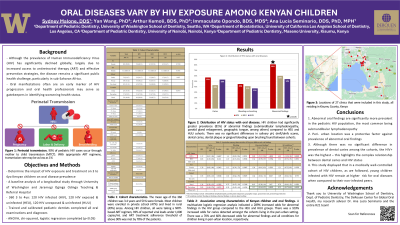Preventive
405 - Oral diseases vary by HIV exposure among Kenyan Children

- SM
Sydney G. Malone, DDS
Pediatric Dental Resident
University of Washington, Seattle, WA
Seattle, Washington, United States - SM
Sydney G. Malone, DDS
University of Washington
- YW
Yan Wang, PhD
University of California, Los Angeles
- AK
Arthur Kemoli, BDS
University of Nairobi
- IO
Immaculate Opondo, BDS, MDS
Maseno University
- AS
Ana Lucia Seminario, DDS, PhD
University of Washington
- AS
Ana Lucia Seminario, DDS, PhD
Associate Professor
University of Washington
Seattle, Washington, United States - TT
Thomas Tanbonliong, DDS
Graduate Program Director, Pediatric Dentistry
University of Washington
Seattle, Washington, United States
Presenting Author(s)
Co-Author(s)
Research Mentor(s)
Program Director(s)
Purpose: The aim of this study was to determine the impact of HIV exposure/treatment on 3-4-year-old Kenyan children on the prevalence of oral disease.
Methods: This cross-sectional study was conducted amongst 31 hospitals in West Kenya of 360 3-4-year-old children. Three cohorts of 120 children each were recruited based on HIV diagnosis: HIV-infected (HIV), exposed at birth but uninfected (HEU) and unexposed uninfected (HUU). Demographics and data using a standardized oral examination were collected alongside ART treatment regimens, duration, viral load and adherence (HIV group). Statistical analysis was conducted using descriptive statistics, t-test and regression analysis (P < .05).
Results: Of the 360 children, the mean age was 3.4 years (SD:0.5) and 51% were female. The majority of children were enrolled in private school (47%) (public (22%); no school(31%)) and lived in rural (49%) (urban (35%), peri-urban (16%)) areas. HIV children had significantly greater prevalence (81%) of abnormal findings (submandibular lymphadenopathy parotid gland enlargement, geographic tongue, among others) compared with those in the HEU (60%) and HUU (54%) groups (P < .001). No significant differences in salivary pH, dmft/dmfs scores, dental caries, dental plaque or gingival bleeding upon brushing were found. Among HIV children, 93% of reported viral loads under the threshold of 1,000 copies/mL (well controlled) while ART treatment adherence threshold of above 90% was met by 78% of the patients.
Conclusions: Children living with HIV with access to ART treatment have significantly more oral diseases than those HEU or HUU. Diagnosing and treating oral diseases in HIV impacted children would improve delivery of care of HIV health providers.
Identify Supporting Agency and Grant Number:

.jpg)